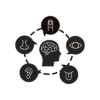
Home > LEARNING AND DEVELOPMENT
LEARNING AND DEVELOPMENT
Adult learning happens only where there is engagement. Inculcating education as an inspiration into organizations, is both an art and a science. Designing L&D solutions that tickle the curiosity, invite self-learning, motivate application and lead to enhanced performance in organizations is achieved through years of experience in L&D concepts and technologies.
L & D PROGRAMS









